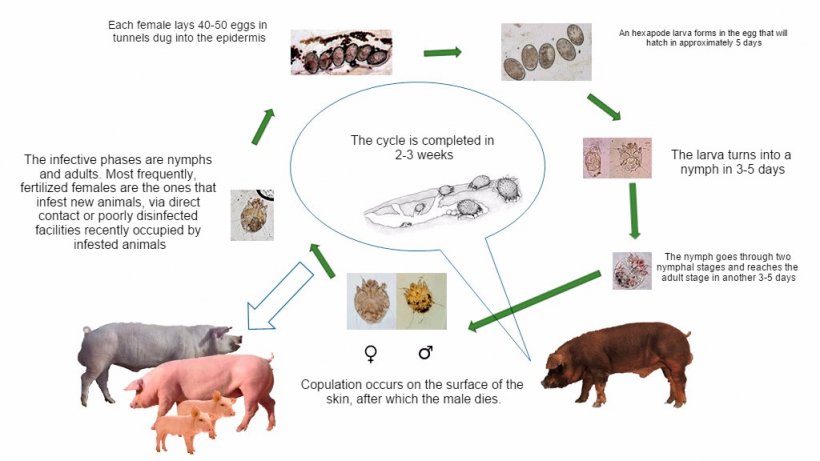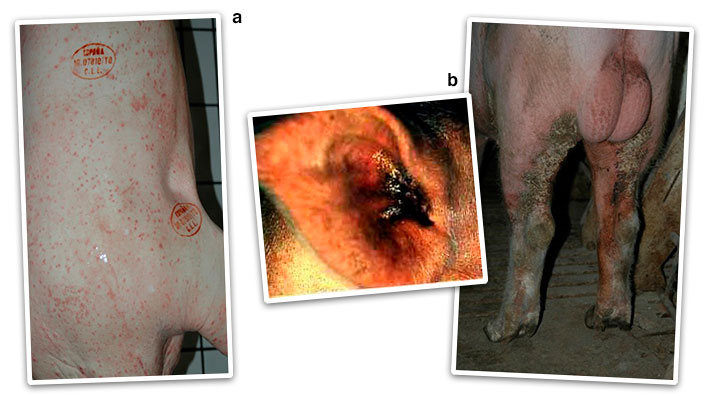Sarcoptic mange is considered the most important ectoparasitoses in pig farms, especially in intensive pig farms. This is due to its wide distribution, negative effects on growth and productive performance and its immunosuppressive effect.

The aetiological agent
The aetiological agent of this disease is Sarcoptes scabiei var. Suis, which requires approximately 15 days (14-21) to complete its life cycle (figure 1.) The main form of disease transmission is direct contact between diseased and healthy pigs; and dissemination is favoured by its subclinical state in some individuals. However, the most important role is played by animals with chronic infestations that harbour a large number of mites in the inner surface of the ear and other body areas. The origin of the infestation can also be the mites present in the environment, as these can survive outside the host for several days and travel up to one meter. The transmission of the parasite via cleaning tools has also been described. Although prevalence will depend on the area studied, the age group or the diagnostic methodology used, the individual prevalence rate in Spain would be close to 30%, and herd prevalence close to 80%, being considered endemic in some regions.

Figure 1. Biological cycle of Sarcoptes scabiei
Clinical presentations
Two clinical presentations are described for sarcoptic mange in pigs. The allergic or erythematous presentation (Figure 2a), which mainly affects rearing and fattening pigs, with characteristic pruritis and presence of papules and red areas on the skin. These begin to appear after an incubation period of 3 to 11 weeks, and their duration varies depending on the hygienic and therapeutic measures implemented. The chronic or hyperkeratotic presentation (also known as "scab") affects older animals, especially in farms with poor management conditions. The typical lesions are whitish scabs that contain hundreds of mites and are located inside the inner surface of the ear, although they sometimes also extend through the body and the hind limbs (Figure 2b.) The presence of the mite is associated with negative effects on reproductive efficiency; maternal behaviour of the sow and lactation; reduction of the growth rate and conversion rate in fattening pigs; exacerbation of other diseases; decrease of market value by depreciation of the carcass; and increase of facilities maintenance costs due to damage caused by the animals' constant scratching. The pigs' stress and discomfort consequently affects the productive parameters, increasing the conversion rate and decreasing the average daily gain, that can go down by a 10%. If it's not controlled, it can cause significant economic losses due to its high morbidity.

Figure 2. Allergic or erythematous presentation (papules and reddened skin areas) (a) and chronic or hyperkeratotic presentation (b).
Diagnosis
To diagnose swine mange is not easy, mainly because the infection is subclinical in most animals, and often there are no visible or specific lesions. Pruritis and restlessness of infested animals can be observed on the farm, as well as skin lesions. Laboratory diagnosis is critical and can be achived by identification of the mite in skin scrapings and the serological diagnosis. This technique may be useful for classifying a farm as positive or negative, since it can detect subclinically infested animals with a low number of mites; assess the individual health status of replacements during quarantine; assess the effectiveness of a control or eradication program against swine mange by means of serological testing; and evaluate the presence of antibodies in animals born after the start of an eradication program. Inspection of carcasses at the slaughterhouse to determine the presence of papular lesions on the skin is also a very useful method to assess the disease status of a herd and to check its evolution after implementing a control programs.
Prevention, control and eradication
Prevention is mainly based on preventing the entry of carrier animals. Ideally, gilts acquired outside the farm should be subjected to serological tests to determine their health status. In any case, all new animals should be checked at the entrance to the farm (paying special attention to ear and hock areas) and subjected to a quarantine period of about three weeks. If deemed appropriate, they would be subjected to a treatment. There are many acaricidal products for the control of the disease. The choice of the appropriate drug depends on several factors, such as economic cost of the treatment, type of facilities, intensity and extent of the problem, number of animals on the farm, and program we intend to apply: control or eradication (Table 1.) In the cases of genetic companies with nucleus and/o multiplication farms,and insemination center, it is advisable to implement eradication programs, since these days, the sale of breeding sows or boars with mange is considered unacceptable.
Table 1. Control and eradication programs: advantages, disadvantages and implementation.

| Control programs seek to reduce most of the losses due to sarcoptic mange by applying an aetiological treatment and disinfection measures at the farm | |||
| Benefits | Disadvantages | Methods | Drugs used |
| - Promote the elimination of clinical mange - Avoid most of the problems caused by the disease - Useful on farms that do not have the material and human resources to implement an eradication program |
- Maintenance of subclinical mange and possible clinical resurgence if treatment is discontinued - They do not completely eliminate production losses - High cost and time-consuming implementation |
- Development of schedules for the application of acaricides | Depending on their administration route: - Spraying (amitraz, diazinon and fosmet) - Pour on (ivermectin, fosmet) - On feed (ivermectin) - Injection (ivermectin, doramectin) |
| Eradication programs: the aim is to completely eliminate mange mites and its consequences from the farm and keeping the herd free. | |||
| Benefits | Disadvantages | Methods | Drugs used |
|
- Completely free the farm of mange mites and keep it disease-free |
- Trained and educated staff | - Implementation of strategic treatments - Establishment of depopulation and repopulation patterns |
Pour on (fosmet) Injection (ivermectin and doramectin) On feed medication (ivermectin, combined with injections) |




